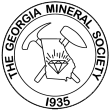"The Gee!-Ode"
What a weird hide,
With such joy inside!
by
Bob Jarrett

The mid-Mississippian Epoch (Visáen, 331 to 347 million years ago) cherty dolomitic limestones and mudstones in the Woodbury - Elkins Church - McMinnville, Tennessee area - and further afield - have long been known to yield quartz "cauliflower" geodes similar to those from Keokuk, Iowa, Central Indiana, and Kentucky. While geodes have formed in igneous rock gas vesicles, desiccation cracks in concretions, sediment gas bubbles, dissolution voids of previously solidified nodules, spaces in fossils, and tectonically created openings, this paper addresses another option, explained by the work of Chowns and Elkins (1974), Maliva (1987), Milliken (1979), Milliken (2003) and others not listed. Pictures without credits are by the author.
Three reader survival notes:
- If the technical jargon becomes too much, scan ahead for more exciting material.
- For brevity, references will be lightly cited, unless major points specifically deserve credit.
- A key intention is to aid rockhounds get excited about what's out there.
Figure 1. Unweathered vug containing quartz and dolomite crystals in situ in dolomite
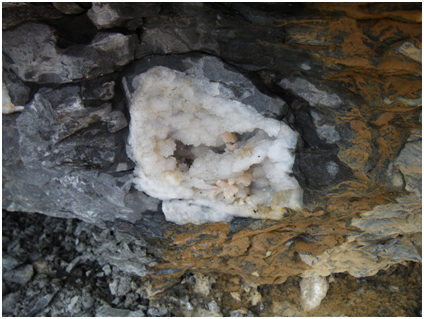

Background
How did all of this happen, and what stories do the geodes tell? We will have to address physical and chemical and physical processes (processes have feedback loops and new starts), starting materials, and resulting structures.
After the Appalachian Mountains formed in Ordovician times and a vast inland sea formed, erosion carried sediments and nutrients westward into the shallow sea. Sea organisms, like, blastoids, brachiopods, bryozoans, crinoids, diatoms, foraminifera, and sponges deposited carbonate and silica remains on the sea bottom to generate the deep deposits of Mississippian limestones and dolo(mitic)stones, Chattanooga and other shales, and cherts.
Especially important for later discussion were the nearshore submerged sediment deposits and intertidal flats. Chowns and Elkins proposed that anhydrite nodules formed in sabkhas (landlocked, near-ocean salt ponds), where concentrated brines could precipitate calcium sulfate without water of crystallization (anhydrite). Maliva cites his own and others' research showing that the chemistry, supported by failure to find anhydrite nodules of such sizes and shapes around the world in similar modern settings, require another explanation.
Coastal swamps accumulated vast amounts of organic matter that became the coal measures we recognize after burial, land subsidence, sea rises and falls, and land re-elevation by tectonic forces. Nearshore (peritidal) zones accumulated carbon-containing land sediments that combined with biological carbonate remains to form carbonaceous, limey mud that turned to stone under pressure and temperature increases resulting from burial by sea rise, tectonic subsidence, and even more sedimentation. And, they joined the layer-cake of rock formations in the same ways as coal. Along the way, other chemical and physical changes occurred. Pressure of further layers of sediments squeezed water out. Natural flow of waters under gravity moved chemicals from one location to another, both vertically and horizontally. Acidity levels, often stated in "pH", changed. Carbonate remains variously compacted, dissolved, and recrystallized to form fossiliferous and non-fossiliferous limestones, as well as changing from aragonite to calcite and back and forth between tiny crystals (micrite) and larger crystals. Many untraceable changes in pressure, temperature and pH over long periods had their effects, probably multiple times; especially on the relative solubilities of elements and minerals and the sequences in which they dissolved and precipitated.
The majority of the Cumberland Plateau limestones arose from the miniscule tests (shells) of foraminifera and other calcium-loving micro-organisms, while the super-microcrystalline cherts eventually re-solidified from gels formed by chemical addition of water to silicon dioxide (basic molecules of quartz) provided by the tests of unimaginable numbers of diatoms and radiolaria tests, and sponges' silica spicules. Production of these micro-sources far outweighed (and still does) that of marine life macro-shells and bones.
All of that leaves us almost back at the beginning! What about the geodes? The plot (Warsaw Formation) thickens! because the Warsaw is the most exciting stratigraphic level of origin for the Woodbury, TN geodes, which may also be found in the underlying Fort Payne Formation. A major note: The literature refers to the Warsaw, while the US Geological Survey map for Tennessee omits that name - making the Warsaw simply the upper continuation of the Fort Payne Formation underlying the St. Louis Formation. In keeping with the references, this paper uses the name Warsaw.
Geodes up to 60 cm in the largest dimension are found in the bituminous dolostones at the base of the Warsaw (Chowns and Elkins, 1974). The bituminous odor released by striking the dolostone is believed to derive from "degraded plant debris". Burial was never deep enough to achieve the 90-150°C required to produce oil or even higher to produce gas. Milliken (2003) convincingly argues that burial was less than 600 meters (1980 ft.) at a temperature of about 40°C.
This portion of the Warsaw is the most productive of the geode yielding formations in the area. The dolostone contains cherty dolo-spiculite interbedding (beds with sponge spicules as a major constituent) and ranges from medium gray to dark gray in color.
Though Maliva (1987) wrote before Milliken (2003), he had assembled a good discussion of the entire geode process based on his own work on the Sanders Group in mid-Indiana, with considerable reference to Chowns and Elkins (1974) and Milliken (1979). All deserve credit here.
Chemistry
Chemistry is critical. As noted, the hypothesis of starting-point gypsum nodules forming in marine-water-fed sabkhas has been laid aside. The more likely process would entail high magnesium, non-marine surface or near-surface waters percolating through carbonate mineral deposits doing two things: 1) precipitating anhydrous calcium sulfate (from water of such high salinity that it is impossible for two water molecules to attach to the calcium sulfate) and 2) magnesium converting calcium carbonates (CaCO3, limestone) to dolomitic ((MgCa(CO3)2) minerals. The making of dolomite would have released a lot of calcium to react with any sulfate in the water and force precipitation of the anhydrite form of calcium sulfate for nodule-making. Seawater does not contain enough sulfate ions to do the job, even after solar concentration in a sabkha. The water had to be from above sea level and likely concentrated in arid zone ponds. The sulfate would have arisen from oxidation of sulfur, hydrogen sulfide, and pyrite (or other metal sulfides).
Morphology (shapes)
This next discussion on morphology is more physical condition and time related. And, looking at a few resulting geodes will help grasp the processes at play. Some are externally spheroidal (fancy for saying almost balls), some are oblate spheroids (sat upon cantaloupes), others are obviously collapsed in upon themselves, and yet a few are multiple or irregular blobs.
Figure 2. Flattened mushroom geode
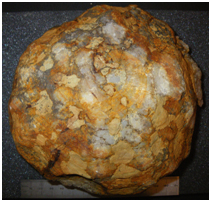 |
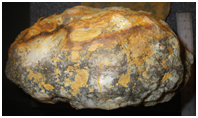 |
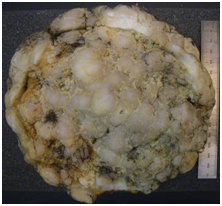 |
| Top | Edge | Collapsed/flattened Bottom |
Surfaces are generally rough, like coarse sandpaper. Woodbury geodes are called cauliflower geodes owing to the appearance of being composed of roughish, interconnected spheroids. The degree of weathering gives distinctive outer appearances. Geodes newly "liberated" from the dolomite groundmass possess a rind of that gray-dark gray material (around top in Fig. 1.). Those found in the overlying tan-brown saprolite have a crust of the tan-brown coloration (Figs. 2 and 3). Geodes that have been in or on the more active soil or exposed to erosive forces may exhibit smooth, translucent, pale blue-gray chalcedony surfaces (Fig. 4).
Figure 3. Dolomite saprolite
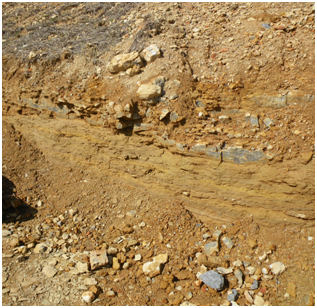

Figure 4. Completely clean exterior showing anhydrite growth "stretch marks"


Milliken believes the geodes to have originated from a smaller fossil or relatively new biological remain, especially of invertebrates (blastoids and brachiopods may predominate). This contrasts with igneous and other parent rock geodes that formed in gas vesicles, root traces, or empty bone fossil molds, for example. It is believed that Woodbury geode formation began relatively soon after deposition of the original "seed" and burial in soft sediments (new big word for frightening children: syn-depositionary = simultaneous with deposition). That is, crystallization of anhydrite began very early in the geological life of the sediment bed and the original item dissolved, both long before the muds settling around could compact, chemically react, and become rock (lithify).
Soft sediments form-fitted around the nodule (note lineations top, bottom, and sides in (Fig. 1). The sediment deformation implies that geode formation (diagenesis) displaced soft sediments, rather than simply replacing bio-remains with crystallized minerals - anhydrite. Also, note in the same figure that weathering and sound waves from recent blasting (traveling at different velocities in dolomite compared to dolomite with inter-crystallized silica) appear to have separated the harder rind from the main matrix. Other, cleaner, blasted samples "popped-out" and show the same effect all around, where no matrix weathering is evident.
Nodule formation increases size dramatically from the originating seed. It is not resolved whether inflation was caused by simple precipitation of more anhydrite and/or slow hydration of anhydrite to gypsum. That hydration can result in a 30% volume increase. In any case, Milliken terms it centrifugal expansion, as seen in a series of three blastoid fossil origin geodes (uncopyable picture in Milliken, 2003). Maliva remarks that distorting expansion can be up to many times the size of the parent fossil or other seed. An example is an assemblage of super expanded caulifower-like florettes comprising the outer envelope of a 29 cm. x 22 cm. x 17 cm. (11.4 in. x 8.7 in. x 6.7 in.) geode (Fig. 4). Several black (dolomitic?) shapes are visible as crust (Fig. 5), plus some partial and some rounded bumps lacking detail. These are not fossil shapes (Chowns, 2013), but anhydrite crystal aggregates would have grown somewhat like the familiar pattern of seafloor spreading with new material forming at a spreading center (new crystals between older, in this case).
Figure 5. Geode external and internal features
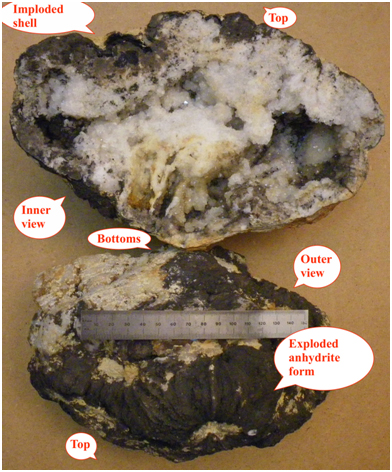

A final morphological comment, Maliva observed that series of geodes tend to lie along trace fossil burrows in Indiana. A tendency was seen at Woodbury, TN for series of geodes to lie in near-horizontal planes that could have been at the interfaces of uncompressed sea bottom oozes, where burrow complexes might be expected. Fig. 6, a "plate geode", shows multiple geode cavities throughout and smaller growths near each other. Fig. 7 shows a long vug/geode series.
Figure 6. Multiple growths on a plate of geodic rock
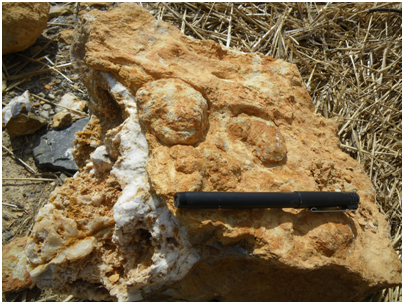

Figure 7. Long series of future geodes along bedding a plane. (Geologist for scale)
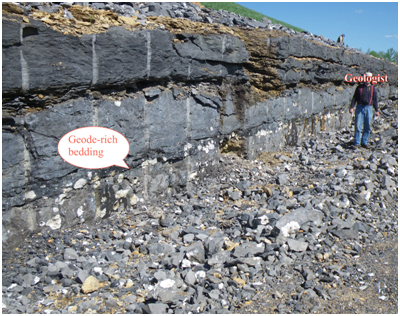

Structure
Woodbury geodes' internal chemical, crystal, and physical structures are revealing and intriguing, though alternately ugly and beautiful. You, the reader, might have asked why discuss anhydrite at such length, when quartz is obviously the predominant mineral. There are reasons that 1) cycle back to chemistry and 2) involve crystallography.
Anhydrite is absolutely known to form nodules that look like cauliflower geodes. A central maxim of geology is: Current geological processes are the key to the past. Secondly, quartz crystals in various sources of Mississippian geodes in the U.S. Midwest have been shown to contain central inclusions of anhydrite. Maliva's (1987) work found anhydrite inclusions in every geode he studied, but none in the matrix outside the geodes. Chowns and Elkins found both anhydrite pseudomorphs on and in Woodbury geodes and anhydrite inclusions in their quartz crystals. In these eggs, anhydrite came first and got surrounded or replaced by quartz. There was no chicken.
Back to chemistry again, the dissolution of sponges' silicon dioxide spicules was the most likely source of silica to form quartz. The Warsaw Formation is laden with spicules; in fact its lower bed just above the Fort Payne Formation is called a spiculite. Spiculite-derived silica in solution replaced the anhydrite and any gypsum in the pre-existing nodules.
Woodbury geodes apparently grew in the following sequence:
- Calcium carbonate bio-remains had empty spaces and/or dissolved
- Saturated calcium sulfate laden fluids flowed through sedimentary deposit pore spaces and anhydrite crystallized in the cavities
- Anhydrite crystallization and/or hydration pressed outwards against the muds as the nodules grew
- Replacement of anhydrite by silica was from outer edges toward the center, as waters became less concentrated allowing anhydrite to dissolve
- Chalcedony, commonly "2-5 mm. dia. spherulitic cryptocrystalline" or microcrystalline deposits, formed a first peripheral layer taking the shapes of any seed and/or making pseudomorphs of anhydrite
- OR making chalcedony that was fibrous (very elongated) or equant (roughly equal axes)
- External pressures exceeded most geodes' strength at some point in these processes and they flattened vertically, some collapsing or inverting into their own internal spaces
- Inward pointing "megaquartz" (easily visible) crystals then grew into the remaining space
- Megaquartz took many habits (crystal shape variants).
- Accessory minerals crystallized in remaining spaces, as waters changed composition through time
Internally, Woodbury geodes run a gamut from truly ugly to very attractive. However, even the ugly ones are technically interesting. One wonders how so many variants could occur. The ugly interiors include: completely solid masses of intergrown quartz or gray, unpretty chalcedony; sugary, crumbly masses of equant or needle like crystals with iron staining; relatively thin, partially hollow shells with loose, 0.1 mm. to 1 cm. sized particles, a klapperstein (German for rattle rocks); and relatively thin shells filled with clay in which free, partial to doubly terminated, quartz crystals may exist. Some fragments, particularly "slices" of the outer geode layers, may fluoresce blotchy white, bluish-white, and yellow or orangish-yellow under both long- and shortwave UV.
Figure 8. Two rattle rock geodes with sandy contents
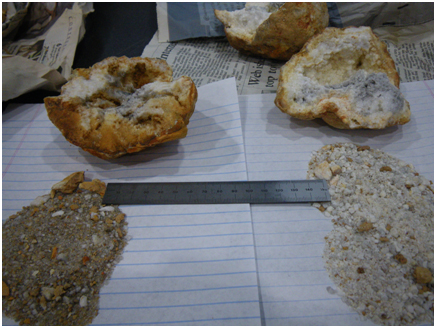
Source: Samples by Charles and Lori Carter; photo by author (2013)

Source: Samples by Charles and Lori Carter; photo by author (2013)
Figure 9. 2-4 mm. Doubly terminated quartz crystals
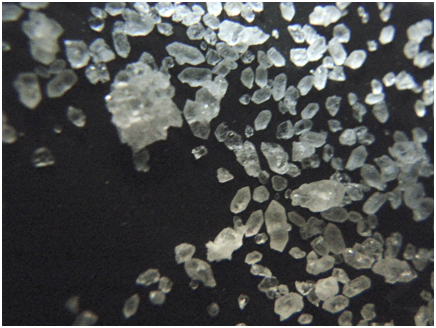
Source: Samples by Charles and Lori Carter; photo by author (2013)

Source: Samples by Charles and Lori Carter; photo by author (2013)
Free quartz crystals are believed to have formed occasionally with minimal physical constraints in the anhydrite body as it was dissolving. Partially collapsed geodes sometimes contain chunks of enfolded gray dolostone or fossil surfaces (Fig. 5). The attractive ones have combinations of brilliant drusy linings, attached balls of equant quartz, multiple rooms, and accessory minerals.
Features to Seek in the Field
Milliken reported these accessory minerals: anhydrite (only as inclusions in quartz), ankerite, aragonite, calcite, celestite, chalcopyrite, dolomite, fluorite, galena, hematite, kaolinite, magnetite, marcasite, millerite, pyrite, and sphalerite. The unusual "cubic" habit of quartz has also been reported to occur rarely. It is not cubic in the true crystallographic sense like pyrite, but most slant faces are so small and major angles so near 90° that crystals appear to be cubes at first glance ( http://www.quartzpage.de/crs_habits.html Accessed 4 Apr 13).
External aspects of beds:
- Anhydrite pseudomorphs
- Silicic dolomite halos around geodes in unweathered matrix
- Burrow geode series on/between sediment laminations and bedding planes
- Fluvial sole and biological trace markings on bedding planes
- Sponge spicules
- Silicified dolomite rinds
- Compressed and collapsed geodes - general shapes
- "Exploded" invertebrate fossils, particularly blastoids
- Sponge spicules attached to outer surface
- Fossil indications - blastoids; possible bryozoans (including brachiopods), crinoids, and sponges; and invertebrate burrow traces
Figure 10. Bryozoan (moss animal) stem part - not a skeletal bone joint, despite possible cracks

Internal aspects of geodes:

- Anhydrite pseudomorphs
- Compressed and collapsed geodes - internalized dolomite and other materials
- Druse quartz and/or botryoidal chalcedony linings
- Enfolded anhydrite growth markings
- Rattle rock (klapperstein) contents - partial crystals to some with double terminations
- Quartz habits - multiple, including pseudocubic
- Secondary minerals (in one or more crystal habits)
- Brecciation
- Fluorescence (opportunity for further mineral identification)
- and (for the microscopically advantaged reader) anhydrite inclusions in quartz and zoned-growth evidence in larger (not micro-) quartz crystals.
- and, (for the even more advantaged) isotope history evidence in geodes' larger zoned crystals, rather than in groundmass microcrystals.
Figure 11. Zoned quartz crystal cross-sections, here approximately 3 mm. diameters
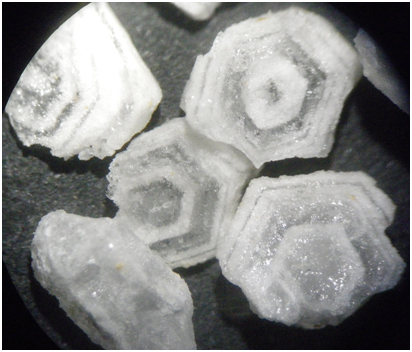
Source: Samples by Charles and Lori Carter; photo by author (2013)

Source: Samples by Charles and Lori Carter; photo by author (2013)
Closing
Chowns, Elkins, Maliva, Milliken, and many others, through their hard work in the Woodbury, TN area, opened a Pandora's box of good things (is that an oxymoron?) to marvel over, collect, and study. As noted at the beginning, the hope behind this article is that all readers will have found information and ideas fitting their respective levels of interest and knowledge without getting too mired in jargon. Nature (Bless her heart!) has been so lavish in her application of a great number of phenomena regarding Woodbury geodes that it is difficult to get one's arms around the whole package.
Where does one go from here? For those who have been to Woodbury, a few more hours of fondling their geode prizes with loupe in hand might be in order - cheap. For others a field trip is a in order - not cheap.
Primary References
Chowns (2013), Personal communication, Marietta, Georgia.
Chowns, T.M., and Elkins, J.E. (1971), Origin of Geodes from the Fort Payne Formation, Woodbury, Tennessee; Geological Society of America Abstracts with Programs, Vol. 3, p. 303 (Abstract). [Unable to obtain full article at reasonable cost.]
-- (1974), The origin of quartz geodes and cauliflower cherts through the silicification of anhydrite nodules, Journal of Sedimentary Petrology, Vol. 44, No. 3, p. 885-903.
Maliva, R. C. (1987), Quartz geodes: Early diagenetic silicified anhydrite nodules related to dolomitization, Journal of Sedimentary Geology, Vol. 57, p.1054-1059.
Milliken, K. L. (1979), The silicified evaporite syndrome: Two aspects of silicification history of former evaporite nodules from southern Kentucky and northern Tennessee: Journal of Sedimentary Petrology, Vol. 49, p. 245-256.
-- (2003), “Geodes”: in Middleton, G. V., et al. (eds.), Encyclopedia of Sediments and Sedimentary Rocks, Kluwer Academic Publishers, p. 306-308.

Copyright © Georgia Mineral Society, Inc.
